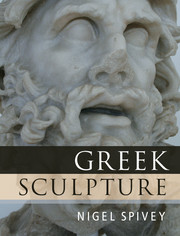Book contents
- Frontmatter
- Dedication
- Contents
- List Of Figures
- Preface
- Note
- 1 Introduction: the Study Of Greek Sculpture
- 2 The Greek Revolution
- 3 Daedalus and the Wings of Technê
- 4 Anathêmata: Gifts for the Gods
- 5 Heroes Apparent
- 6 Temple Stories
- 7 In Search of Pheidias
- 8 Revealing Aphrodite
- 9 Royal Patronage
- 10 Portraits and Personifications
- 11 Graecia Capta
- 12 Afterlife
- Index
12 - Afterlife
Published online by Cambridge University Press: 01 December 2014
- Frontmatter
- Dedication
- Contents
- List Of Figures
- Preface
- Note
- 1 Introduction: the Study Of Greek Sculpture
- 2 The Greek Revolution
- 3 Daedalus and the Wings of Technê
- 4 Anathêmata: Gifts for the Gods
- 5 Heroes Apparent
- 6 Temple Stories
- 7 In Search of Pheidias
- 8 Revealing Aphrodite
- 9 Royal Patronage
- 10 Portraits and Personifications
- 11 Graecia Capta
- 12 Afterlife
- Index
Summary
Activity at the sculpture workshop at Aphrodisias seems to have continued up until the early fifth century AD. But it is conventional to establish a terminus for Greek sculpture about a century earlier. Setting aside the geopolitical changes signalled by Constantine's decision to locate (in AD 324) his administration on the site of an old Greek colony called Byzantium, the stylistic evidence from the last major pagan monument erected at Rome – the triumphal arch voted by the Senate in Constantine's honour (AD 312–15) – is enough, in the eyes of many modern observers, to mark the end of ‘Classical antiquity’. Further to describe it as a definitive ‘decline of form’ is tendentious; yet by this time, it seems (to judge by an edict attributed to Constantine), the traditional craft skills of Greek sculptors were in short supply. Materially, there is only sparse and scattered evidence for their practice.
To draw a line with the Arch of Constantine is to say that whatever happens to Greek sculpture thereafter must be counted as part of its ‘afterlife’. The term afterlife may, however, raise expectations that this chapter fails to meet. In German it would be Nachleben: and that word brings with it a specialized discipline within academic art history, which is the study of how the forms of images in the Classical repertoire were utilized by artists from the early Middle Ages onwards. Aby Warburg (1886–1929) was the pioneer of this discipline and is honoured by an institute to his name. The sort of Nachleben that fascinated Warburg may be typified by one of his first case-studies, following the visual trail of a Classical motif usually referred to as the Dancing Maenad (Figure 12.1). The prototype of this motif remains obscure: an Athenian monument of the late fifth century seems likely, possibly a representation of the Chorus from Euripides’ The Bacchae by an artist called Kallimachos, famed for his ‘fussy’ drapery. There may have been eight or nine of these figures, all in various postures of Dionysiac ecstasy, on the original monument; numerous copies and derivations from them were made, in many media, in Roman times. For Warburg, the power of the motif consisted in its encapsulation of an extreme emotional state: an artist had only to ‘quote’ the figure of a frenzied Maenad to evoke that psychological state.
- Type
- Chapter
- Information
- Greek Sculpture , pp. 300 - 323Publisher: Cambridge University PressPrint publication year: 2013



